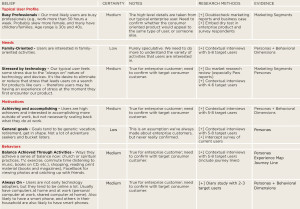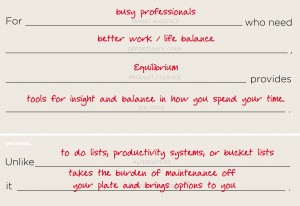-
UX Method of the Week: Learning Plan
Posted on
What do you know, what don’t you know, and how are you going to learn it?
A learning plan sounds like a formal concept, but really it’s just about taking the time to ask yourself where the gaps are in your current understanding of users’ needs and experiences, and how you can fill in that understanding. A surprisingly large number of people claim to practice user-centered design, but fail to ever actually speak with or spend time with users. Don’t be like them. One of the core tenets of a user-centered philosophy is that you respect and learn from your users’ sometimes unpredictable lives. A learning plan is a simple tool that you can use by yourself or with a team to map out what you know and what you need to learn.
Try It Out
- Start with what you know.
Set aside 30 minutes or an hour to free-list everything you think you know about your users What are your working assumptions? - Separate certainties from assumptions.
For each assumption, indicate how confident you are in that assumption. While you do this, look for any questions that can be grouped together and simplified. - Brainstorm research methods.
Now, for each of your questions, brainstorm how you might go about getting more data or info in this area. Also think about what resources will be required to actually answer these questions (for example, face-to-face time with users, a Web intercept survey, access to server log data, etc.). Note that not all research questions will require direct and immediate access to customers. Some answers can be derived from tools or processes that users touch—for example, call center transcripts, search analytics, and so on. Be creative in thinking about where and how you can gather data to answer your questions. - Plan outputs.
Finally, for each area that you’d like to research further, think about what form your evidence will take (for example, presenting and distributing new personas).
What’s the most unlikely place where you’ve uncovered great data about your users?Post your reply as a comment below by Tuesday, 11/26, midnight PT. The best reply wins a free copy of The User Experience Team of One.
UX Method of the Week: Strategy Workshop
Posted on
What is our vision for the ideal user experience, and what do we need to focus on to bring that unique experience to life?
There is a special moment that’s just right for a strategy workshop, and it’s early in the process before design has been kicked off. It’s the time when optimism and interest in “what could be” are at their highest. This stage gets people when they are most likely to engage with an open mind, and times it so that strategic thinking can influence the ultimate work plan.
In a strategy workshop, you’re leveraging the collective wisdom of a cross-functional team to begin to establish a vision and a strategy for your user experience. When people talk about strategy, often they’re using the same word to talk about very different concepts. To one person, strategy is about prioritization and having a timeline. To another, it might mean establishing a vision for the future. Neither is wrong, and a strategy workshop can help you get clarity on both.
A stakeholder workshop can include a hodgepodge of different activities, depending on your needs for that particular project, team, and time. Possible activities include:
- Triads help you explore the identity of your product, starting with a simple word-listing exercise. For this activity, get the team to brainstorm a list of keywords that they would like the product to embody. Pick three words that you’d put together to describe the core of the product experience. Work with the group to identify combos that are interesting to them. Then, for that particular three-word combo, brainstorm related nouns, verbs, and adjectives that might go with a product built around this triad.
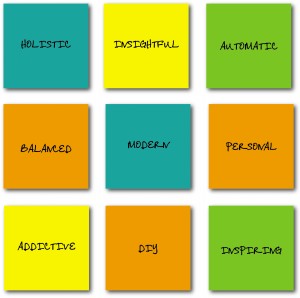
- An elevator pitch helps you align around a shared description of your product and what’s special about it. For this activity, you can use a template to create a succinct statement of what distinguishes your product from its competitor or comparator offerings. The elevator pitch can help you understand what differentiates the offering, and hence, which features and characteristics should serve as the defining elements of the product. It can also help you prioritize by shining a light on what matters most in delivering on the core value proposition of the product.
What’s YOUR best activity for involving stakeholders in UX vision?Post your reply as a comment below by Tuesday, 11/19, midnight PT. The best reply wins a free copy of The User Experience Team of One.
UX Method of the Week: Opportunity Workshop
Posted on
An opportunity workshop is a way to quickly assess what work needs to be done to improve the user experience, what’s highest priority from a business perspective, and what will have the most impact from a user perspective.
Use an opportunity workshop when you find yourself having general discussions about the need for an improved user experience, but there is no clear momentum or sense of how to get there.
Average Time
3–4 hours total
- 1 hour to plan and invite people
- 2 hours to conduct workshop
- 1 hour to document what you learned and plan the next steps
Try It Out
- Host a work session.
Block off at least two hours on the calendar and invite together a cross-functional team of people who all work on the product. - State the goals of the work session.
- Uncover problem areas.
Guide the team in a pain storm activity on Post-it notes or index cards, as shown in Figure 5.8. Ask everyone to write down as many things they can think of that are:- A problem in the current product
- A missed opportunity in the current product
- Just plain important to get right in the product
- One-by-one, ask people to share their Post-it notes, and put them on the wall where others can see them.
- Start with what you know.
Next, ask the team to write down the product’s strengths—again, one strength per sticky note, as shown in Figure 5.9. It’s useful to follow problem areas with strengths so that the team ends on a positive note, even if the overall discussion may have been constructively critical.
Next, guide the team in an activity to organize the issues that were identified into related groupings. Once some clear groups begin to emerge, ask the team to label each group. Put the label on another sticky note (preferably of a different size or color, so it stands out from the other Post-its) so everyone can easily stand back and see the issues and opportunities as broad themes.
Now, lead the team in a prioritization exercise. This could just be a discussion. Or, to make it more structured, give everyone a certain number of votes, and ask them to put their votes next to the clusters that they think are most urgent to address, improve, or enhance.
Once the priorities have been clearly identified, lead the group in a discussion about how urgently these should be addressed, and how you’d like to address them.
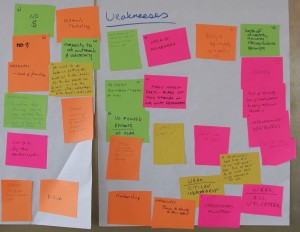
What’s YOUR favorite way to assess how to improve a product’s UX?
Post your reply as a comment below by Tuesday, 11/12, midnight PT. The best reply wins a free copy of The User Experience Team of One.
UX Method of the Week: Project Brief
Posted on
A project brief helps you get aligned on expected outcomes for a user-centered design project.
Often, when a project is beginning, everyone involved has distinct ideas for what the right outcome looks like. In team discussions, it’s possible for people to express their point of view and think they’re all saying the same thing, but actually have very different ideas of what they expect to see. A project brief states directly what goals or expectations should prevail as the main mandate for the work.
The brief, as its name suggests, capitalizes on the cardinal virtue of brevity to distinctly and clearly summarize the overall plan for the project: what you’re doing, why you’re doing it, relevant constraints that will drive your work, and what outcomes you expect. Another bonus of the brief is that by being a short description, it’s more likely that people will actually read it. This creates an opportunity for everyone to agree or, if not agree, at least have a productive conversation about the focus and goals of the project.
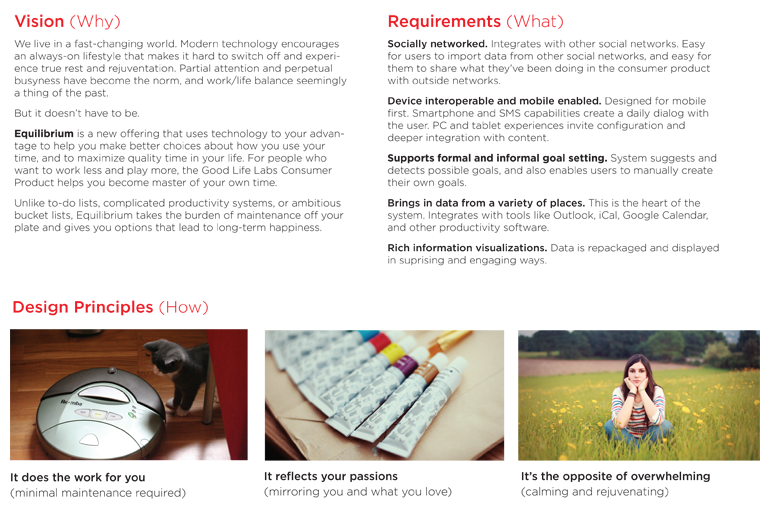
Ever done a project brief? If so, how did you involve others on your team?
Post your reply as a comment below by Tuesday, 11/5, midnight PT. The best reply wins a free copy of The User Experience Team of One.
UX Method of the Week: Listening Tour
Posted on
Ever done a listening tour? What tip would you share with others?
Post your reply as a comment below by Tuesday, 10/29, midnight PT. The best reply wins a free copy of The User Experience Team of One.
UX Method of the Week: UX Project Plan
Posted on
What’s your best tip for creating accurate UX project plans?
Post your reply as a comment below by Tuesday, 10/22, midnight PT. The best reply wins a free copy of The User Experience Team of One.
UX Method of the Week: UX Questionnaire
Posted on
What’s the most important question you ask when kicking off a project?
Post your reply as a comment below by Tuesday, 10/15, midnight PT. The best reply wins a free copy of The User Experience Team of One.
27 Weeks of UX Methods
Posted on
I’m excited to announce that starting next week we’ll be kicking off a weekly series called UX Method* of the Week.
The idea is simple:
- Each week, one method from The User Experience Team of One will be featured on twitter and on this book web site.
- For the featured method, I’ll ask folks to share their best tips.
- Then I’ll pick the most clever and brilliant tip that’s been shared.
The author of the winning tip will receive a free copy of the book (valued at $39) and public adulation from yours truly over on the twitters (priceless).
We’ll kick things off next week with method #1, the UX Questionnaire. If you want to participate, be sure to follow me on twitter @ugleah, or check back here periodically to see the latest method and reply with your own best tips.
* Why methods? Well, because I love UX methods. I love what they stand for: self-contained, UX-focused activities that you can inject into your process to achieve new and different outcomes. My love of methods should be no surprise to readers of The User Experience Team of One. Part two of the book is a reference-style compendium of 27 methods. When done in order, they comprise a start-to-finish blueprint for taking on a project as a UX team of one.
The User Experience Team of One Will Be Available on July 9
Posted on
A few days ago, I found myself sitting at my kitchen table watching fireworks explode. They were meant to celebrate independence day here in the United States, but somehow they felt like they were special ordered just for me. The first printed copies of my book had just arrived in the mail. At long last, The User Experience Team of One is real! From the stunning, psychedelic cover to the easy-on-the-eyes interior, it looks fantastic.
The book will officially be available for sale on July 9th.
To celebrate its release and kick it off right, I’ll be hosting a UX Team of One workshop at UXPA on July 9th and a User Interface Engineering virtual seminar on July 11th (where I’ll be attempting to cram as much of the book as possible into a brisk 90 minutes).
I hope you’ll consider you’ll consider joining me for the workshop or the virtual seminar. And of course, I invite you to check out the book. It’s the first to address this topic head on, and I believe it will be relevant to many user experience professionals working around the world today.
Tips for freelancers
Posted on
Leisa Reichelt just published a really great article called 10 Tips for UX Freelancing that I wanted to pass along. Why tips for freelancers?
As a part of book research, I’ve been having some illuminating conversations with UX teams of one lately. In one of those conversations @mojoguzzi (the Joe behind Regular Joe Consulting) opened my eyes to how many teams of one are freelancers, and how unique their challenges can be.
Leisa’s list is a great resource if you’re a freelancing team of one. Know of any other good resources for UX freelancers? Please share.
